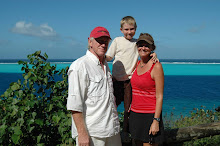It's beer, it's cold and it's a tower. What more can you say?

These are the travels of the Bloomquists aboard our Nordhavn 64, Oso Blanco.


 We had a wonderful time with them and hated to see them leave so soon!
We had a wonderful time with them and hated to see them leave so soon! Driving by, we stopped to check it out. Bear was the only one with a swimsuit so he got in with a Fijian woman to lather up in mud to experience its "soothing and medicinal" qualities. Bear just found it slimey and prefered the neighboring clear, hot pool which felt "like the hot tub in Utah".
Driving by, we stopped to check it out. Bear was the only one with a swimsuit so he got in with a Fijian woman to lather up in mud to experience its "soothing and medicinal" qualities. Bear just found it slimey and prefered the neighboring clear, hot pool which felt "like the hot tub in Utah".
 t somewhat reluctant, the headmaster warmed to us, showed us the school and mosque and answered our questions. He was especially kind to Bear and engaged him in much conversation. Not being prayer time (which is five times daily) we entered the mosque. Women and men never pray alongside one another and women generally are not allowed in the central prayer area. Per our host's invitation, I cautiously stepped inside where two Muslim men were lying on the floor. One of them clearly was upset with my presence and exchanged words with our host. I offered to leave but our host stood firm and said I was welcome and to ignore these men. Some young male students came by and shook Eric and Bear's hands. They did not look me in the eye. It was uncomfortable for me as a woman to feel this prejudice because of my gender but it is part of their religious culture.
t somewhat reluctant, the headmaster warmed to us, showed us the school and mosque and answered our questions. He was especially kind to Bear and engaged him in much conversation. Not being prayer time (which is five times daily) we entered the mosque. Women and men never pray alongside one another and women generally are not allowed in the central prayer area. Per our host's invitation, I cautiously stepped inside where two Muslim men were lying on the floor. One of them clearly was upset with my presence and exchanged words with our host. I offered to leave but our host stood firm and said I was welcome and to ignore these men. Some young male students came by and shook Eric and Bear's hands. They did not look me in the eye. It was uncomfortable for me as a woman to feel this prejudice because of my gender but it is part of their religious culture. boost when the Beatle, John Lennon, joined), Krishna has its historical roots in Hinduism. Most of us identify Krishna's with the bald, orange robed men in airports. Their mission is to spread their spiritual knowledge and techniques to the population at large, especially through dance and song. With less than one million members worldwide, the Krishnas numbers are relatively small yet they are visible in society. Interestingly, Fiji has the highest percentage of Hare Krishnas in the population of any country in the world. We were disappointed on our visit as the temple was closed and no people were present.
boost when the Beatle, John Lennon, joined), Krishna has its historical roots in Hinduism. Most of us identify Krishna's with the bald, orange robed men in airports. Their mission is to spread their spiritual knowledge and techniques to the population at large, especially through dance and song. With less than one million members worldwide, the Krishnas numbers are relatively small yet they are visible in society. Interestingly, Fiji has the highest percentage of Hare Krishnas in the population of any country in the world. We were disappointed on our visit as the temple was closed and no people were present. e Hindus in 1994, visitors are welcome if dressed appropriately: legs and arms covered, shoes removed, modesty and good behavior at all times. However, we did learn through experience (as my calves and arms were prominently displayed) that paying the entrance fee pretty much waived the rules. The interior of the temple was very impressive with beautiful hand painted murals on the ceilings, individual shrines to various gods and mosaic rock patterns adorning the walls. Bear thought the bright colors made the place look like a circus!
e Hindus in 1994, visitors are welcome if dressed appropriately: legs and arms covered, shoes removed, modesty and good behavior at all times. However, we did learn through experience (as my calves and arms were prominently displayed) that paying the entrance fee pretty much waived the rules. The interior of the temple was very impressive with beautiful hand painted murals on the ceilings, individual shrines to various gods and mosaic rock patterns adorning the walls. Bear thought the bright colors made the place look like a circus!





